The return of Mexico's famous Tequila Express train
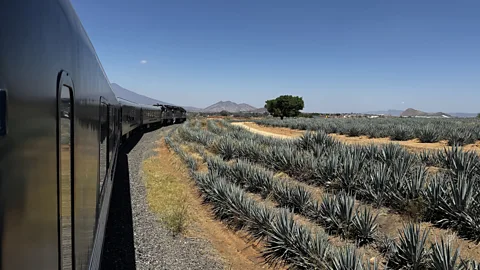 Jamie Fullerton
Jamie FullertonWith "tequila tourism" gaining popularity in Mexico, a train taking tourists to the home of the spirit has relaunched after nine years away. The Tequila Express offers a gateway to an intriguing culture, alongside impressive on-board cocktails.
As I boarded the Tequila Express at Guadalajara railway station, a tour guide with curly gelled hair was holding court in a bar carriage. Holding a gold-coloured microphone and a bottle of tequila, he spoke enthusiastically to a group of Mexican tourists about their country's famous spirit. At 10:30, when the train left the station, he handed out shot glasses.
From Nuremberg's Techno Train to the late-night London to Margate Train, I've witnessed many chaotic alcohol-soaked railway adventures. I wondered if the long-awaited return of the Tequila Express, the tourist train running between the city of Guadalajara and the town of Tequila in Mexico's Jalisco state, would signal a similar experience.
The Tequila Express launched in 1997 to serve the nascent "tequila tourism" industry in Tequila, its namesake city, which now has a population of around 45,000 and is the epicentre of the tequila industry, home to around 25 distilleries. Knocking back tequila on the two-hour, 65km ride across Jalisco's cactus- and agave plant-lined landscape proved popular, and, in 2012, the Jose Cuervo tequila company launched a rival – and much more expensive – tourist train on the same route.
The original Tequila Express stopped running in 2015; in 2017, the train was used for a tourist service in collaboration with the Herradura tequila brand. In 2020, the Herradura service was also shuttered, as Covid decimated tourism.
The Tequila Express finally returned in September 2024. Mexico's tourism industry was healthy again, and by 2023, Tequila was attracting 1.2 million visitors a year, with more distilleries offering tours. Government authorities and tourism companies reportedly invested around 170 million pesos (£7m) to get one of the world's most unique short-distance tourist trains, which offers a trip directly to the heart of the culture behind Mexico's most famous export, back on track.
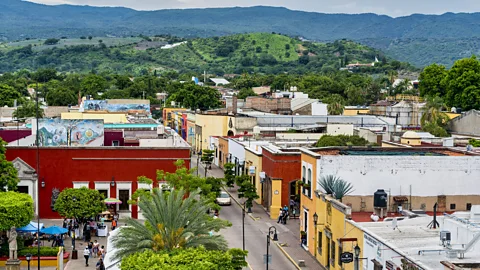 Getty Images
Getty ImagesCarriages were refurbished for the relaunch, to the degree that my journey felt more boutique hotel than party train. I'm teetotal, so at a marble-topped bar I ordered Almave, a non-alcoholic spirit made from the same agave plants used for tequila. Piped mariachi music was constant, and tasteful low-light lamps were attached to wood-panelled walls. TV screens showed distilleries and tacos: pleasures awaiting us in Tequila.
Onboard, I chatted to Antonio Cabrera from northern Mexico, who told me he was 55, but only now taking his first Mexican train journey. With Mexico currently lacking a country-wide passenger rail network, its best-known trains are arguably tourist routes such as the Tequila Express, the controversial new Tren Maya, and the Chepe Express Copper Canyon train. There were a few European backpacker types dotted throughout the carriages, but most passengers were well-dressed middle-aged Mexicans, like Cabrera.
Train Journeys
Train Journeys is a BBC Travel series that celebrates the world's most interesting train rides and inspires readers to travel overland.
As a bartender stirred a creamy cocktail, carefully placing herb sprigs on its textured glass, Cabrera and I happily agreed that there seemed little sign of the trip getting messy, at least before we got to Tequila. The mic-wielding guide explained flavour notes as tourists gently sipped. Cabrera himself was drinking Corona. "I'm from the border area; tequila is not that popular there," he said. "But I want to try tequila later."
The drinks had a socially lubricating, if not quite party-starting, effect. An exuberant American in a floppy sunhat named Leigh was on her second Tequila Express trip, and eager to talk about the previous ride. "People were dancing as they got more inebriated," she said. Silverton belly danced as we trundled past rows of Agave tequilana, the species of large, spiky blue agave farmed for tequila.
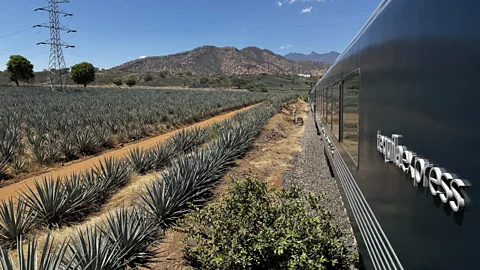 Jamie Fullerton
Jamie FullertonThe train's carriage windows were enlarged during the refurbishment to allow for better views. In the far distance, Jalisco's mountains loomed over orange-dry land. The agaves, planted by farmers with regimental precision and bearing blue sword-like leaves, had conquered the dirt all around us.
The agaves' ubiquity can be explained by regulations. Since 1974, for tequila to legally be tequila, it has needed to be produced in Jalisco or one of the designated tequila municipalities located in four other states. In 2006, Unesco named Tequila's cinematic, agave-dominated rural landscape, along with the town's ancient industrial facilities, a World Heritage site.
Plan your trip
When to go: The Tequila Express runs between Guadalajara and Tequila year-round.
How to book: Buy Tequila Express tickets at Tequilaexpress.mx (Spanish-language site). One-way tickets cost from 1,150 pesos (£45) and return tickets cost from 1,785 pesos (£67) each. Day trips including train tickets, a bilingual-guided Sauza distillery and agave field tour, town centre tour, meal, all transportation, plus drinks (including alcohol) and snacks on the train, cost 3,900 pesos (£150) per person. The Sauza-based day trips are only available on Saturdays.
When we arrived at Tequila's Sun-blasted single-platform station, buses took tourists to agave fields and the massive distillery owned by Sauza, a major tequila producer. Passengers can buy these tours as part of train ticket packages or explore Tequila independently after departing the Tequila Express.
I'd arranged to meet tour guide Luis Alberto Gutiérrez Rojas in the town's main square. We met by the large, colourful "TEQUILA" letter blocks erected for Insta-tourism impact. Around us, street musicians created a sound-swirl of guitar, trumpet, accordion, double bass and wailing vocals.
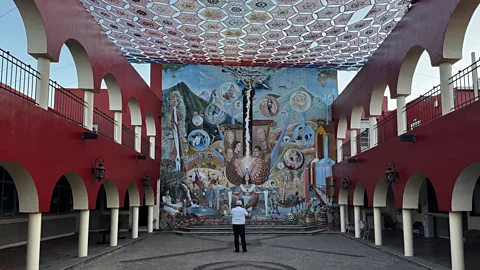 Jamie Fullerton
Jamie FullertonGutiérrez showed me a vast mural depicting lightning striking agave plants. This, he said, represented Indigenous people discovering the liquid that would become tequila, long before the Spaniards arrived in the 1500s. According to legend, after lightning struck agaves, juice from the burned plants fermented and the alcoholic discovery was made.
He pointed out the faces of people from tequila-producing families depicted in the mural. The Cuervo and Sauza families were among Tequila's early commercial distillers, beginning in the 18th and 19th Centuries, respectively. These names still adorn some of Tequila's biggest distilleries.
More like this:
• The Train Maya: Mexico's ambitious new tourism megaproject
• A 58-tunnel slow train through India's Eastern Ghats
• The Baltic Express: Central Europe's new hop-on hop-off train
We walked along Calle José Cuervo – as well as a distillery, an entire street bears the Cuervo name – and into a small cantina. A green sign behind the frayed wooden bar read: "One More Batanga".
La Capilla is Tequila's oldest cantina and a place the Tequila Express staff said I must visit – for atmosphere if not alcohol. The batanga cocktail was reportedly created here in the 1960s by founder Don Javier Delgado Corona, using Coca-Cola, lime and El Tequileño Blanco tequila made in a distillery 500m from the bar. Don Javier died in 2020 aged 96, but still keeps watch over the bar in portrait form, depicted with white hair and offering a batanga.
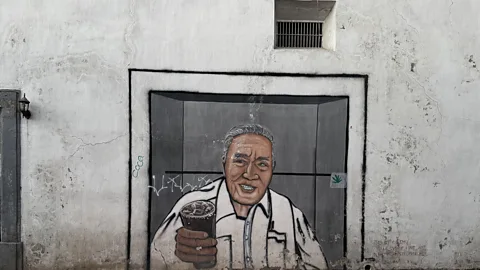 Jamie Fullerton
Jamie FullertonI ordered a "virgin" batanga from the barman, who assured me that he was related to Don Javier. I gave two guitar-toting musicians wearing huge black hats 100 pesos (£3.80) to play a jaunty song, then got chatting with an agave farmer. I nodded as he complained about the plant's price dropping to under 10 pesos (38p) per kilogram due to supply outstripping demand.
The next morning, I was on farmland myself. I'd booked a tour with Atanasio Tequila, a small distillery also recommended by Tequila Express staff. Sheccid Carranza, who started working with Atanasio after her family invested in the company, took me to the distillery's agave field in the back of a truck.
Some other Tequila tours, including Sauza's, also visit agave fields. But many are more about consumption than education, with reggaeton-blasting party trucks designed to resemble tequila barrels carrying shot-downing tourists around town. "Drinking, drinking, drinking," said Carranza. "We were forgetting about the essence, the roots… we don't appreciate how much the field workers work."
Picking up a barretón – a shovel-like tool – Carranza stabbed the base of a large agave then pulled up a pineapple-sized mini-agave. She held it aloft, like a hunter with freshly slain prey. This was a hijuelo, a young agave that grows from its parent via asexual reproduction.
"Your turn," said Carranza. I made 40 barretón stabs to a nearby hijuelo's base before hearing the crunch signalling that I could pull the spiky infant agave free. Carranza said that if I were a real field worker, harvesting one hijuelo would earn me one peso (4p). Planting it away from its parent plant, where it would grow for around seven years before being harvested, would earn me another peso.
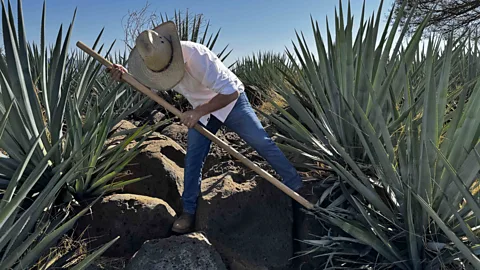 Jamie Fullerton
Jamie FullertonCarranza said that these field tours show that behind every tequila shot is a culture of hard work and farming experience. She handed me a pick-axe-like tool called a talache and ordered me to dig a hijuelo hole.
I thudded the talache into the ground. As red dirt flew up, I considered how, rather than a ticket to alcohol oblivion, the Tequila Express opens up a far more insightful ride.
--
If you liked this story, sign up for The Essential List newsletter – a handpicked selection of features, videos and can't-miss news, delivered to your inbox twice a week.
